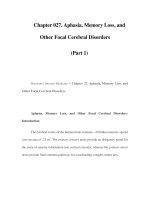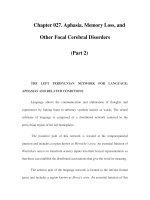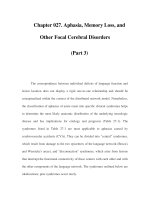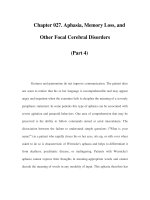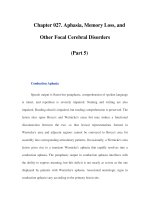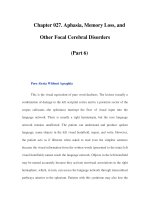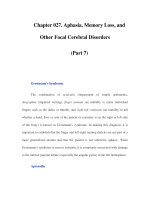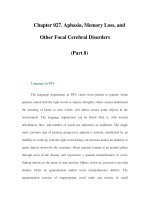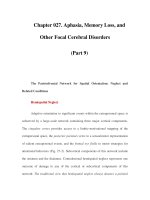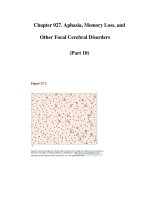Chapter 031. Pharyngitis, Sinusitis, Otitis, and Other Upper Respiratory Tract Infections (Part 2) docx
Bạn đang xem bản rút gọn của tài liệu. Xem và tải ngay bản đầy đủ của tài liệu tại đây (14.28 KB, 5 trang )
Chapter 031. Pharyngitis, Sinusitis, Otitis, and Other
Upper Respiratory Tract Infections
(Part 2)
Upper Respiratory Infections: Treatment
Antibiotics have no role in the treatment of uncomplicated nonspecific
URI. In the absence of clinical evidence of bacterial infection, treatment remains
entirely symptom-based, with use of decongestants and nonsteroidal anti-
inflammatory drugs. Other therapies directed at specific symptoms are often
useful, including dextromethorphan for cough and lozenges with topical anesthetic
for sore throat. Clinical trials of zinc, vitamin C, echinacea, and other alternative
remedies have revealed no consistent benefit for the treatment of nonspecific URI.
Infections of the Sinus
Sinusitis refers to an inflammatory condition involving the four paired
structures surrounding the nasal cavities. Although most cases of sinusitis involve
more than one sinus, the maxillary sinus is most commonly involved; next in
frequency are the ethmoid, frontal, and sphenoid sinuses. Each sinus is lined with
a respiratory epithelium that produces mucus, which is transported out by ciliary
action through the sinus ostium and into the nasal cavity. Normally, mucus does
not accumulate in the sinuses, which remain sterile despite their adjacency to the
bacterium-filled nasal passages. When the sinus ostia are obstructed, however, or
when ciliary clearance is impaired or absent, the secretions can be retained,
producing the typical signs and symptoms of sinusitis. The retained secretions may
become infected with a variety of pathogens, including viruses, bacteria, and
fungi. Sinusitis affects a tremendous proportion of the population, accounts for
millions of visits to primary care physicians each year, and is the fifth leading
diagnosis for which antibiotics are prescribed. It is typically classified by duration
of illness (acute vs. chronic); by etiology (infectious vs. noninfectious); and, when
infectious, by the offending pathogen type (viral, bacterial, or fungal).
Acute Sinusitis
Acute sinusitis—defined as sinusitis of <4 weeks' duration—constitutes the
vast majority of sinusitis cases. Most cases are diagnosed in the ambulatory care
setting and occur primarily as a consequence of a preceding viral URI.
Differentiating acute bacterial and viral sinusitis on clinical grounds is difficult.
Therefore, it is perhaps unsurprising that antibiotics are prescribed frequently (in
85–98% of all cases) for this condition.
Etiology
A number of infectious and noninfectious factors can contribute to acute
obstruction of the sinus ostia or impairment of ciliary clearance, with consequent
sinusitis. Noninfectious causes include allergic rhinitis (with either mucosal edema
or polyp obstruction), barotrauma (e.g., from deep-sea diving or air travel), or
chemical irritants. Illnesses such as nasal and sinus tumors (e.g., squamous cell
carcinoma) or granulomatous diseases (e.g., Wegener's granulomatosis or
rhinoscleroma) can also produce obstruction of the sinus ostia, while conditions
leading to altered mucus content (e.g., cystic fibrosis) can cause sinusitis through
impaired mucus clearance. In the hospital setting, nasotracheal intubation is a
major risk factor for nosocomial sinusitis in intensive care units.
Acute infectious sinusitis can be caused by a variety of organisms,
including viruses, bacteria, and fungi. Viral rhinosinusitis is far more common
than bacterial sinusitis, although relatively few studies have sampled sinus
aspirates for the presence of different viruses. In those studies that have done so,
the viruses most commonly isolated—both alone and with bacteria—have been
rhinovirus, parainfluenza virus, and influenza virus. Bacterial causes of sinusitis
have been better described. Among community-acquired cases, S. pneumoniae and
nontypable Haemophilus influenzae are the most common pathogens, accounting
for 50–60% of cases. Moraxella catarrhalis causes disease in a significant
percentage (20%) of children but less often in adults. Other streptococcal species
and Staphylococcus aureus cause only a small percentage of cases, although there
is increasing concern about community strains of methicillin-resistant S. aureus
(MRSA) as an emerging cause. Anaerobes are occasionally found in association
with infections of the roots of premolar teeth that spread into the adjacent
maxillary sinuses. The role of Chlamydophila pneumoniae and Mycoplasma
pneumoniae in the pathogenesis of acute sinusitis is still unclear. Nosocomial
cases are commonly associated with bacteria found in the hospital environment,
including S. aureus, Pseudomonas aeruginosa, Serratia marcescens, Klebsiella
pneumoniae, and Enterobacter species. Often, these infections are polymicrobial
and involve organisms that are highly resistant to numerous antibiotics. Fungi are
also established causes of sinusitis, although most acute cases are in
immunocompromised patients and represent invasive, life-threatening infections.
The best-known example is rhinocerebral mucormycosis caused by fungi of the
order Mucorales, which includes Rhizopus, Rhizomucor, Mucor, Absidia, and
Cunninghamella. These infections usually occur in diabetic patients with
ketoacidosis but also develop in transplant recipients, patients with hematologic
malignancies, and patients receiving chronic glucocorticoid or deferoxamine
therapy. Other hyaline molds, such as Aspergillus and Fusarium species, are also
occasional causes of this disease.
